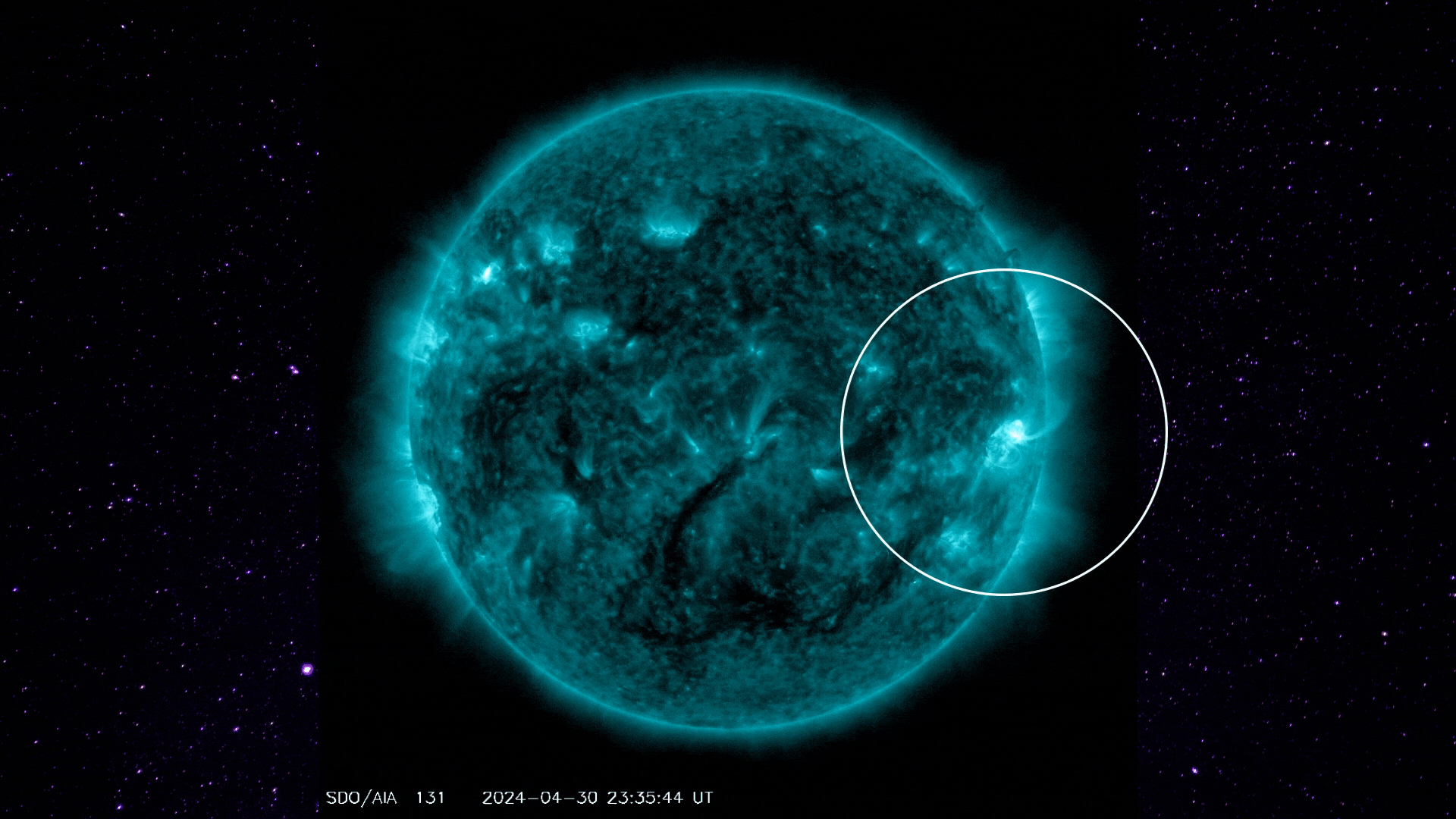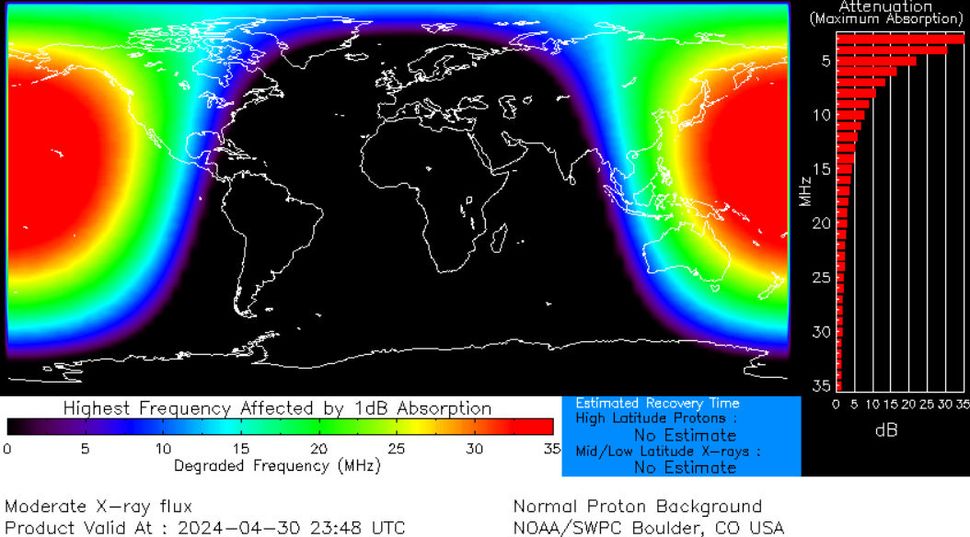
Posted on 05/01/2024 7:59:12 AM PDT by Red Badger
The solar flare is the most powerful eruption from sunspot region R3654 yet.
Last night (April 30), the sun released an extremely powerful solar flare triggering widespread radio blackouts across the Pacific region. The flare peaked at 7:46 p.m. EDT (2346 GMT) and ended shortly after at 7:58 p.m. EDT (2358).
Solar flares are eruptions from the sun's surface that emit intense bursts of electromagnetic radiation. They are created when magnetic energy builds up in the solar atmosphere and is released. Solar flares are categorized by size into lettered groups, with X-class being the most powerful. Then there are M-class flares that are 10 times less powerful than X-class flares, followed by C-class flares which are 10 times weaker than M-class flares, B-class are 10 times weaker than C-class flares and finally, A-class flares which are 10 times weaker than B-class flares and have no noticeable consequences on Earth.
Within each class, numbers from 1-10 (and beyond for X-class flares) describe a flare's relative strength. The recent April 30 flare clocked in at M9.53, according to Spaceweatherlive.com, measured by NASA's GOES-16 satellite, which puts it just a fraction below an X-class solar flare.
Shortwave radio blackouts like the one witnessed over the Pacific are common shortly after powerful solar flare eruptions due to the strong pulse of X-rays and extreme ultraviolet radiation emitted during the event. The radiation travels toward Earth at the speed of light and ionizes the top of Earth's atmosphere when it reaches us.

The solar flare is the most powerful eruption from sunspot region R3654 yet. (Image credit: NASA / SDO and the AIA, EVE, and HMI science teams / helioviewer.org. Annotated by Daisy Dobrijevic in Canva.) This ionization causes a higher-density environment that the high-frequency shortwave radio signals must attempt to navigate through to support communication over long distances. The radio waves that interact with electrons in the ionized layers lose energy due to more frequent collisions, and this can lead to radio signals becoming degraded or completely absorbed according to the National Oceanic and Atmospheric Administration (NOAA) Space Weather Prediction Center.
Radiation from the April 30 solar flare affected those on the sunlit portion of Earth at the time of the eruption, the Pacific regions. "Mariners and ham radio operators may have noticed loss of signal below 20 MHz for as much as 30 minutes after the flare's peak," according to Spaceweather.com.

High frequency radio blackout across the Pacific regions was reported by NOAA's Space Weather Prediction Center. (Image credit: NOAA/SWPC) Solar activity is ramping up as we approach solar maximum, the peak of solar activity during the sun's approximately 11-year solar cycle, indicated by the frequency of sunspots.
Despite the large number of sunspots currently visible on the sun's surface, our star has been relatively quiet in recent weeks. But not anymore.
The near X-class solar flare erupted from the sunspot region AR3654, the most powerful eruption from this region yet.
"It is always exciting when a sunspot region lives up to its potential. AR3654 has just done that." solar scientist Alex Young posted on X.
"Despite high sunspot numbers for the last couple of weeks, tonight's near X-class #SolarFlare is the first decent-sized flare in some time! When and where will the next X-class event come from?" solar astrophysicist Ryan French posted on X.
Solar scientists are keeping a watchful eye on the sun as it approaches solar maximum because solar activity can impact our lives on Earth.
Powerful flares can significantly affect spacecraft, satellites and ground-based technologies, traveling at the speed of light, and they don't give a lot of notice before striking. That's why numerous organizations — including NASA, NOAA and the U.S. Air Force Weather Agency (AFWA) — are monitoring the sun closely. These organizations can send out warnings to technology and infrastructure sectors vulnerable to solar flare activity so that appropriate precautions can be taken in the event of potentially harmful space weather.
"We can't ignore space weather, but we can take appropriate measures to protect ourselves," NASA says.
But there is no need to worry; so-called "killer flares" do not exist and although solar flares have the potential to significantly disrupt the technological world, they don't contain enough energy to do any lasting damage to Earth itself.
"Even at their worst, the sun's flares are not physically capable of destroying Earth," NASA says.
We’re all gonna die! Ping!...................

HAARP, OTOH... 🤗
(See, it's always what these folks *don't* tell you..)

We’re all gonna die! Ping!
Every 11 years , LOL
 ............
............

Oh yeah? Many others do not agree with that blithe dismissal.
Evidence for a Solar Flare Cause of the Pleistocene Mass Extinction
Published online by Cambridge University Press
18 July 2016
The hypothesis is presented that an abrupt rise in atmospheric radiocarbon concentration evident in the Cariaco Basin varve record at 12,837 ± 10 cal yr BP, contemporaneous with the Rancholabrean termination, may have been produced by a super-sized solar proton event (SPE) having a fluence of ~1.3 × 1011 protons/cm2. A SPE of this magnitude would have been large enough to deliver a lethal radiation dose of at least 3–6 Sv to the Earth's surface, and hence could have been a principal cause of the final termination of the Pleistocene megafauna and several genera of smaller mammals and birds. The event time-correlates with a large-magnitude acidity spike found at 1708.65 m in the GISP2 Greenland ice record, which is associated with high NO-3 ion concentrations and a rapid rise in 10Be deposition rate, all of which are indicators of a sudden cosmicray influx. The depletion of nitrate ions within this acidic ice layer suggests that the snowpack surface at that time was exposed to intense UV for a prolonged period, which is consistent with a temporary destruction of the polar ozone layer by solar cosmic rays. The acidity event also coincides with a large-magnitude, abrupt climatic excursion and is associated with elevated ammonium ion concentrations, an indicator of global fires.
Of the 97 geoarchaeological sites of this study that bridge the Pleistocene-Holocene transition (last deglaciation), approximately two thirds have a black organic-rich layer or “black mat” in the form of mollic paleosols, aquolls, diatomites, or algal mats with radiocarbon ages suggesting they are stratigraphic manifestations of the Younger Dryas cooling episode 10,900 B.P. to 9,800 B.P. (radiocarbon years). This layer or mat covers the Clovis-age landscape or surface on which the last remnants of the terminal Pleistocene megafauna are recorded. Stratigraphically and chronologically the extinction appears to have been catastrophic, seemingly too sudden and extensive for either human predation or climate change to have been the primary cause. This sudden Rancholabrean termination at 10,900 ± 50 B.P. appears to have coincided with the sudden climatic switch from Allerød warming to Younger Dryas cooling. Recent evidence for extraterrestrial impact, although not yet compelling, needs further testing because a remarkable major perturbation occurred at 10,900 B.P. that needs to be explained.
X-class solar flare? My first thought was “What’s Elon up to now?”
But, could it fry our communication systems?
But it is our carbon footprint that controls the climate....
This layer or mat covers the Clovis-age landscape or surface on which the last remnants of the terminal Pleistocene megafauna are recorded.
—
The black mat represents 4% of Earth’s vegetation at the time; most of the burning was caused by mega-fires burning out of control & creating firestorms. This period lasted most of 100 years.
So he says,
Even if something has a .0000001% chance of happening, if done often enough, it’ll happen.
Eventually the sun will cook, and then eat us, assuming it doesn’t have some sort of weird flare that we never thought possible which wipes us out, or some anomoly where its output suddenly drops and we all freeze to death while worrying about global warming: https://en.wikipedia.org/wiki/Maunder_Minimum
Of course we may be wiped out before then by a big rock from space that hits us, depending on what random collisions occure in the Astriod belt and what is hurled our way: https://en.wikipedia.org/wiki/Chicxulub_crater
Meantime, narasistic and self important man will pretend that his plastic shopping bag or use of a car will end the planet.
Of course we’re all gonna die again.
It’s staggering to think that natural winters and rainy season rainfalls wouldn’t have put the fires out.
In approximately 4 billion years, give or take a millennia or two, our Sun will swell up to the size of Mars orbit, becoming a Red Giant. Everything inside that diameter will become a memory..........................
Truer words were never spoken.
Disclaimer: Opinions posted on Free Republic are those of the individual posters and do not necessarily represent the opinion of Free Republic or its management. All materials posted herein are protected by copyright law and the exemption for fair use of copyrighted works.